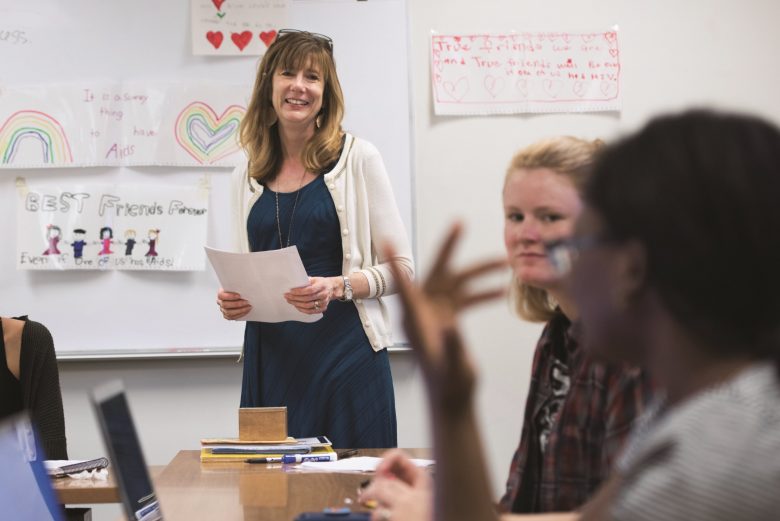Fair, professor of public health studies and human service studies and Watts/Thompson Professor, is one of eight Elon faculty members featured this year in "Passionately Curious," the annual Elon University President's Report.
Each year, Elon University points a spotlight on its truly exceptional faculty and their dedication to excellent teaching, scholarly accomplishment and transformative mentoring in the President’s Report. In this year’s report, “Elon University Faculty: Passionately Curious,” featured educators were asked to write about their intellectual passion and how they share that passion with their students inside and outside the classroom.

Standing at that turquoise table watching my father inject first the orange, and then my mother, made me realize there is no such thing as an illness that only affects one person. My mother was ill. My father, siblings, neighbors and I were all part of supporting her as she dealt with diabetes and related complications. It is necessary to examine illness in context considering the entire person and her environment. My childhood experiences shaped my clinical and research interests in illness and families. How does the illness of a family member shape the experiences of others? What are ways to support families affected by illness? How do roles shift and change over time?
My entire professional career has focused on one particular illness: HIV (human immunodeficiency virus). Originally, HIV was solely considered a “gay disease.” However, despite preconceived notions, other groups were also affected. Pediatricians in major cities began to notice that sick mothers were giving birth to sick babies — babies with the same symptoms as the gay men dying of AIDS. Perinatal HIV infection (PHIV) was publicly acknowledged in 1983. Researchers learned that HIV could be transmitted during pregnancy, delivery and later through breastmilk.
I worked as a social worker at the National Institutes of Health (NIH) during the early 1990s. For the first time, clinical trials examined the safety and efficacy of medications to treat HIV infection (antiretroviral treatment, or ART) for children with HIV. Children across the country flew to NIH to be evaluated and enrolled in experimental therapy. I conducted psychosocial assessments, supported families as they made decisions about disclosure and treatment regimens, and identified resources in their home communities. I observed firsthand the physical devastation caused by HIV, as well as the emotional consequences due to stigma.
Since then, medical advances and improved access to treatment have shifted HIV infection from a death sentence to a chronic illness. We learned that giving HIV-positive pregnant women ART during pregnancy and labor could reduce the risk of mother-to-child-transmission from 30 percent to less than 2 percent. The number of children born with PHIV dramatically decreased and those previously infected began to live longer.
My scholarship follows the evolution of the field of pediatric HIV and began with innovative interventions, such as telephone support groups and art therapy. As children lived longer, I examined their transition into adolescence and young adulthood. The medical community and their guardians seemed surprised that youth with PHIV behaved much like their uninfected peers, exploring sexuality and taking risks. However, children with PHIV had not been expected to live and most experienced significant loss in their lives. How would they navigate young adulthood under such conditions?
I am most interested in the lived experience of adolescents and young adults, rather than a singular focus on one outcome. For example, how does a person establish a romantic relationship when she has lived with HIV her entire life? Does he want to become a father and does he understand the risk of HIV transmission? How do youth with PHIV transition from pediatric care to adult care where they are expected to manage medical decisions independently? How do parents with PHIV deal with disclosure to their children?
My latest research focuses on an emerging population in the U.S.: internationally adopted children with HIV. Very little is known about the needs and experience of adoptive parents and children. Answering these questions contributes to the broader academic and clinical conversations surrounding pediatric and adolescent HIV and amplifies the voices of those who live with HIV.
Throughout my career at Elon, I have consistently integrated my clinical work and research into classes. Perhaps one of the most fulfilling aspects has been helping young scholars craft meaningful and feasible research questions that move the fields of social work and public health forward. I have mentored student research that has been presented internationally and published in top-tier journals. What an honor to stand with students at their turquoise table and help guide them toward their own lines of inquiry and self-discovery.


